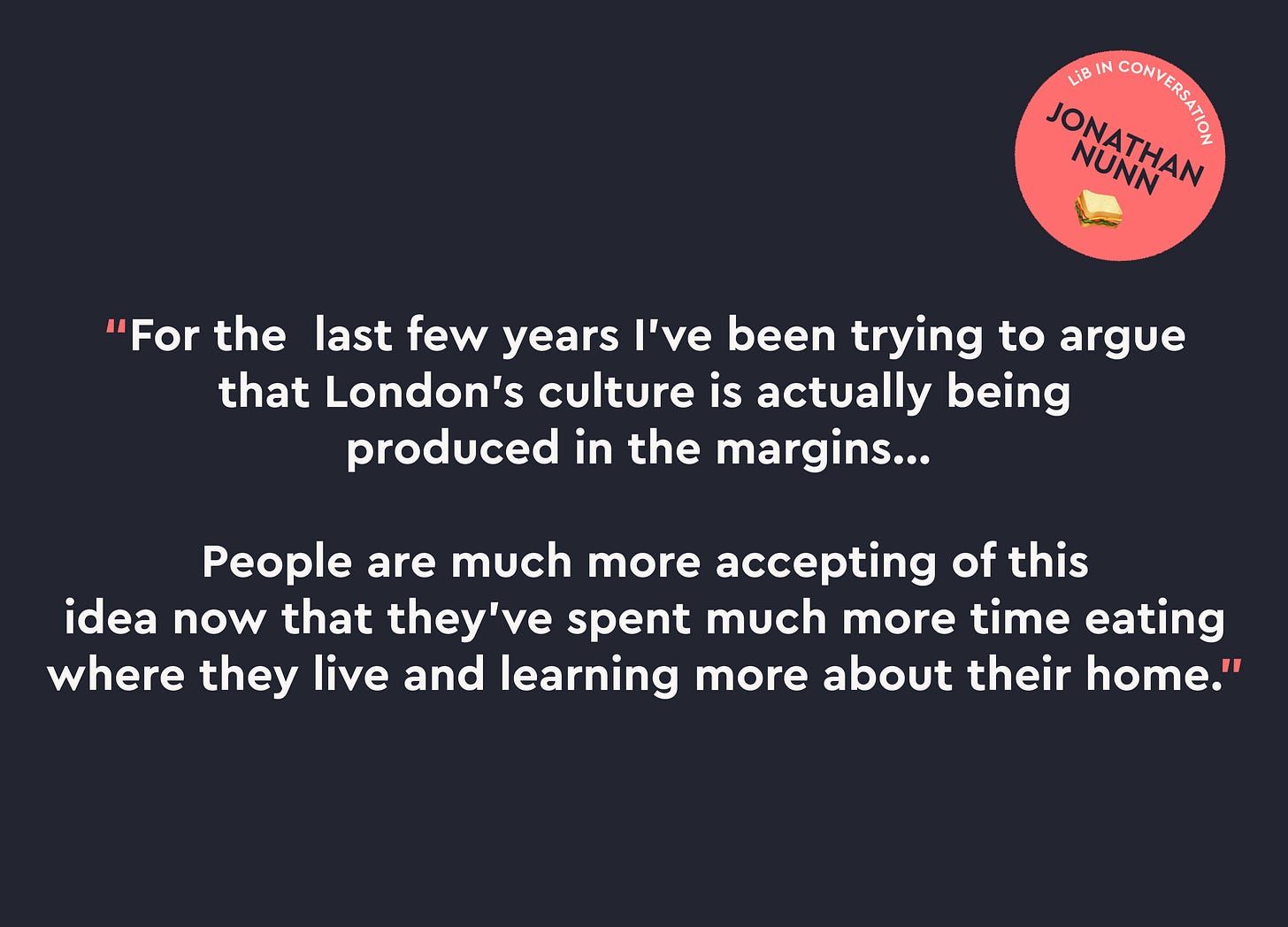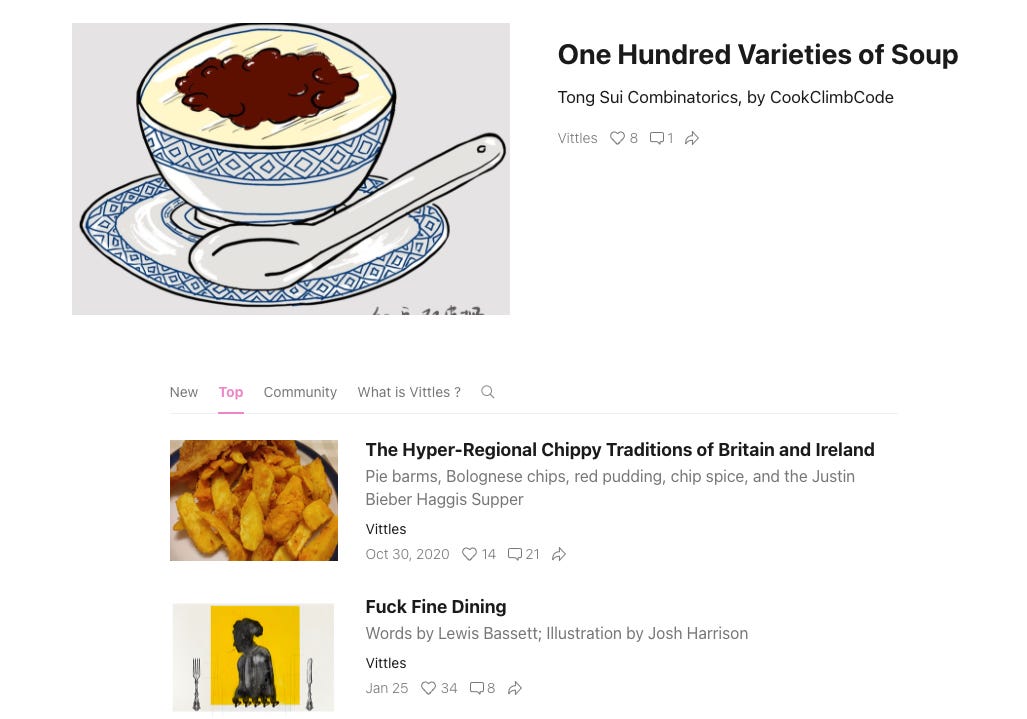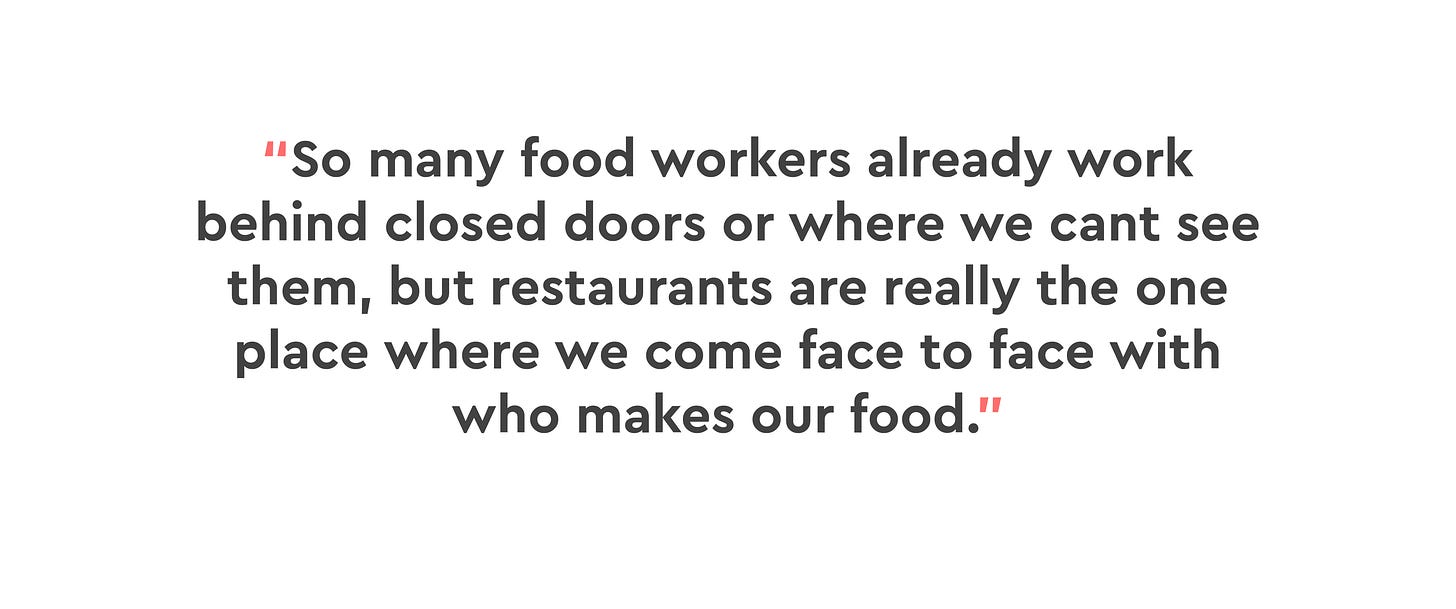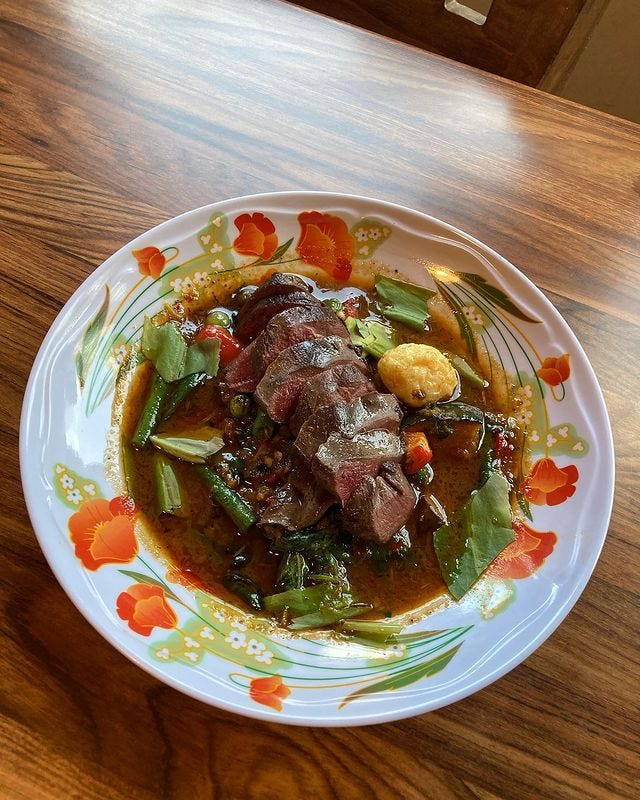Well, we almost made it to the end of 2021 without interviewing another Substack writer, but today we’re ending that trend, and for good reason.
Jonathan Nunn has been writing about London and food for a long time. His writing for Eater London ranges from articles on the fragility of Elephant and Castle as a “vital London food hub” to where to find the best fried chicken. He’s written about ‘sourdough bros’ for Prospect magazine, and more recently he’s penned some great opinions for the Guardian (including this one on Britain’s food-based class wars). And of course he’s the editor of the excellent Vittles newsletter (more on that below).
We spoke to Jonathan about the fate of London’s restaurants post-lockdown, why it’s important to pay your way as a restaurant writer, why delivery apps are bad news for restaurants and cities… And, of course, Salt Bae.
For those who don't know you, can you give us the potted biography?
I guess I’m a food writer, although I’m increasingly finding that term unhelpful. My writing has a strong focus on diaspora restaurants in London, and more and more I think I’m maybe a London writer. I always try to use food as a Trojan horse to talk about place and how London is changing.
I’ve lived in London all my life - my dad was born here and my mother moved here from Kenya in the 70s. It feels significant to have both of those experiences of London as part of my heritage.
How would you describe your newsletter Vittles, and what led you to start your own newsletter just as we went into lockdown?
Vittles is really two things in one. The first is a publication made up of many voices which many people contribute to. As an editor, I try to commission things which muddle the idea of what is currently considered ‘the centre’ in British food writing, particularly who this writing is for.
Right from the offset I wanted to platform voices and positionalities that weren’t really being given the time of day in the media, and allow people who usually don't feel seen by food writing to feel seen. I feel the best compliment anyone can give the writing is that it made them feel like food writing is for them.
At first I envisioned both the writers and the audience to be British, because there’s so many things here yet to be written about, even in London, but Vittles has quickly expanded to encompass global issues and publishes many writers from outside the UK. But ultimately I do see its heart as being in London, which is why the second publication, which is paywalled, is currently my own writing on London food culture (although this is soon going to change.)
What’s been your favourite issue of Vittles so far?
My favourite issue of Vittles is always the one I published last. If I had to pick one from this season, just to give an idea of how Vittles tackles a subject as widely written about as London, then it would be the adopted food piece which was written by Yvonne Maxwell, Feroz Gajia, Jesse Bernard and Tom Victor.
It was about food or restaurants or whole cuisines which have been adopted by different communities - Turkish restaurants by South Asians, for example, or how challah bread is widely eaten by people of West African and Caribbean heritage. I loved how it complicated the idea of who eats what in London, and also how much I learnt about my own city from editing it.
Back in April of 2020 you wrote this opinion piece for the Guardian about the future of restaurants, and what you hoped might happen as we came out of lockdown. Would you say you’re more or less optimistic about where the restaurant industry is heading right now? Have you noticed any changes as you've been able to venture out in the past few months?
I wrote that opinion piece knowing in my heart of hearts that really nothing positive for restaurants would come out of lockdown, at least on the macro level. But I thought it was as good a time as any to name what the problems were: razor thin margins caught between customer unwillingness to pay properly for their food on one end, and on the other, high rents, high rates, and an unsustainable property market.
I had a sliver of hope that the central London restaurant market (which is completely saturated and every restaurant so squeezed that it leads to a kind of safe homogeneity) might slow down a little, but it’s already back and more insane than ever. So in that sense, I'm much less optimistic.
If lockdown has changed anything, I think it’s actually more of a mentality, that perhaps there is more of worth closer to the places we live in than we previously thought. For the last few years I've been trying to argue that, due to the housing market, gentrification, displacement, and a general shift to the suburbs, that central London is no longer the city’s engine and that London’s culture is actually being produced in the margins, with multiple centres usually located in areas with energetic first and second generation diaspora communities.
When I used to say this, a lot of people were skeptical this was true, at least with restaurants. But I think people are much more accepting of this idea now that they’ve spent much more time eating where they live and learning more about their home.
You recently wrote an issue on the worst value restaurants in London. What, to you, constitutes poor value in a restaurant, and do you have any tips on how to avoid a bad value restaurant?
I think value is often something that can only be determined the moment you actually pay your bill. This is why I think it’s important to insist on paying your way as a restaurant writer, if you can, because it’s in that split second where you might get a pang of resentment that you're paying too much, where you know whether this thing was good or bad value.
Of course, you can get bad value in cheap restaurants and great value at expensive restaurants, and it isn’t always about what those ingredients cost. Rather it is that gap between what you feel the meal ─ which means the food, the setting, the skill of the chef, the warmth of the restaurant ─ costs, and what it actually costs. Unfortunately there's no real way to know this before getting the bill.
How did your 99 Great Value Places To Eat Lunch Near Oxford Circus Which Aren’t Pret list come about, and are you continuing to update it?
It was from thinking about my usual map writing and how most people use my recommendations to pick a destination restaurant, which they may then spend a long time travelling to. I wanted to do the exact opposite of that: a map that was limited to a small area and would be used by people with very little time, maybe a half hour lunch break. So I drew from my own experiences, having worked around Oxford Circus for the last ten years and doing as much as I can to avoid surrendering to Pret.


At the moment it’s limited to the areas around Oxford Circus, so Fitzrovia, Mayfair, Soho and Marylebone. But I’m slowly expanding it to Bloomsbury and might add things from the other place I work, which is Camden, and fill in the gap towards Euston which currently has quite a few interesting new mainland Chinese restaurants.
We’ve written quite a bit about dark kitchens, delivery apps etc in the past few months. What’s your take on Deliveroo, UberEats etc?
I think my take is fairly obvious from my writing about them. On a personal level, I don’t use them because it disconnects me from the thing I find most appealing about restaurants, which is a sense of place. I've used the apps twice and hated the experience both times.
On a broader level, I think they’re extremely bad news for restaurants and cities, and especially for workers who we’re more and more comfortable having out of sight. So many food workers already work behind closed doors or where we can't see them, but restaurants are really the one place where we come face to face with who makes our food. I think it's dangerous to substitute this for convenience.
Having said that, it’s not going to simply go away without regulation. It’s clearly a potent idea and it’s going to be the future even though no one is making money yet. The only solution I really see is some kind of collective effort, either from restaurants together, or hospitality workers uniting with delivery workers, to ensure both that people are being paid good wages and that small businesses aren't being exploited by these companies.
Currently the IWGB union is doing really vital work on organising couriers, but there is still this gap between the delivery workers and the restaurants they work alongside.
Al fresco dining in London: Yes or no?
It works for about ten days of the year and the rest of the time the idea is nicer than the experience.
Have you ever been in one of those American candy stores on Oxford Street? Did you buy anything?
I’ve only been in to work out if they are money laundering operations.
What’s the best food experience within walking distance of your house?
I think I have a larger radius of what I consider walkable than a lot of people, but it would probably be Kaieteur Kitchen in Elephant and Castle (above), which is a Guyanese restaurant run by Faye Gomes. She has a knack of always cooking exactly what I need at that moment in time, and infusing it with a care that is almost maternal. The more I eat around London, the more and more I realise how rare and precious this skill is.
If you were offered a completely complimentary, no-strings-attached meal at Salt Bae’s restaurant, would you go?
Not only would I go, I’m already considering paying my own money. I want to be findommed by him.
What’s the one London restaurant that can’t close down because if it did you would actually shed tears?
And the rest…
Back in 2019 Sadiq Khan rejected plans to build the ‘Tulip’ skyscraper next to the Gherkin, because it “would harm the skyline”. Now it looks like Michael Gove might be set to overrule that rejection. It was reported this weekend that the housing minister “is expected to give the plans for a 300m tower the OK.”
An artist has been chosen to design the national Windrush monument that will be installed at Waterloo next year. Basil Watson’s depiction of “three figures – a man, woman and child – dressed in their ‘Sunday best’ climbing a mountain of suitcases hand-in-hand” beat three other entries, but there is now some dispute over the statue’s location, with calls for the monument to be erected in Brixton’s Windrush Square instead.
The Tube map has been reimagined for Black History Month with all 272 stations renamed to celebrate “the rich and varied contribution Black people have made to London and the UK from Pre Tudor times to the present day.” Some of the people honoured in the map include the first Black British circus owner, the first known Black, female individual to serve in the Royal Navy, and the Nigerian-born novelist Florence Onyebuchi “Buchi” Emecheta OBE who left her husband after he burned the manuscript of her first novel, before going on to raise “her five children alone – working at the British Museum by day and studying for a Sociology degree at night.”
A David Bowie pop up store is coming to 14 Heddon Street (just off Regent Street… if you own a copy of The Rise And Fall Of Ziggy Stardust And The Spiders From Mars then you’ll recognise it). The store will have Bowie collectibles including “small batch vinyl releases and apparel” plus a Bowie Gallery featuring “rare photos and art as well as a 360 degree music experience.”
Netflix is coming to Enfield. The company has just signed a deal to build a major new production site there, including “sound stages, studios, as well as set production and make up and break out areas.”
Coravin normally produce gadgets to make your wine last longer, but as of next month they’re also opening a wine bar in Mayfair that will boast “the longest list of bubbles by the glass in the UK” with prices ranging from £8 a glass to £850 a glass. The bar’s not permanent though, it opens on Nov 2 and will be gone again by the end of January.
And while we’re talking restaurants: Grace Dent visited that new Lina Stores in King’s Cross… and really did not like it.










